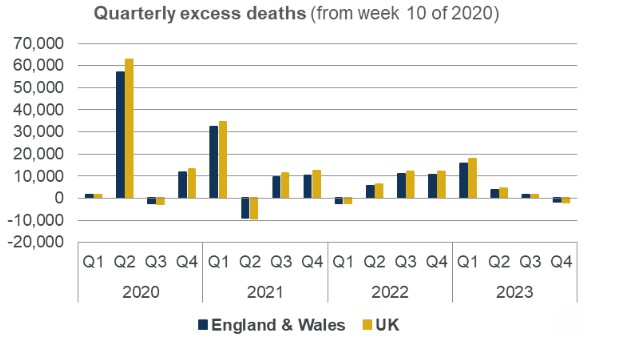While mortality rates in England and Wales were 3% higher last year than before the pandemic, they were lower than 2020, 2021 and 2022.
This is according to the Continuous Mortality Investigation (CMI) which publishes frequent UK mortality analysis through its mortality monitors.
The key points of its latest updates include:
- In England and Wales, mortality for 2023 was 3% higher than 2019, the pre-pandemic benchmark, but lower than in 2020, 2021 and 2022.
- There was a striking difference in how mortality rates in 2023 compare to 2019 at different ages – ranging from 10% higher for ages 20-44 to 1% higher for ages 75-84.
- In the UK, there were around 173,800 more registered deaths from all causes, compared to pre-pandemic, than expected from the start of the pandemic to 5 January 2024. Of these, 74,700 were registered in 2020, 49,000 in 2021, 28,000 in 2022, and 22,000 in 2023.
- Excess deaths have been falling during 2023 and were close to zero (i.e. deaths were broadly as expected) in the second half of the year.
- There were 18,900 deaths registered in the UK in 2023 with Covid-19 mentioned on the death certificate. While broadly similar to the number of excess deaths, the relationship between excess deaths and Covid deaths were found to have varied significantly by age and over the course of the year.

Cobus Daneel, chairman of the CMI Mortality Projections Committee, (pictured) said: “The fourth quarter of 2023 saw negative excess mortality for the first time since the first quarter of 2022.
“Overall, 2023 had the third lowest mortality rate on record – with only 2014 and 2019 being lower. However, we note that 2014 was nearly a decade ago, and if mortality had improved at the same rate as in the latter part of the 20th century, mortality rates in 2023 would have been lower.”
The CMI pointed out that mortality monitors have been updated to take account of revised population estimates that lead us to decrease our estimate of excess mortality since the start of the coronavirus pandemic. This primarily affected excess deaths measured in 2022 and 2023, with excess deaths in 2020 and 2021 relatively unchanged.
It also pointed out that it plans to stop calculating excess mortality after this week’s monitor adding that while monitoring excess deaths was informative early in the pandemic, calculation of excess deaths becomes more subjective the further we get from the pre-pandemic benchmark year of 2019.
It concluded that it will still include standardised mortality rates in future versions of the monitor and while users will be able to see how mortality in each year compares, it will no longer make a comparison to a pre-pandemic benchmark.






